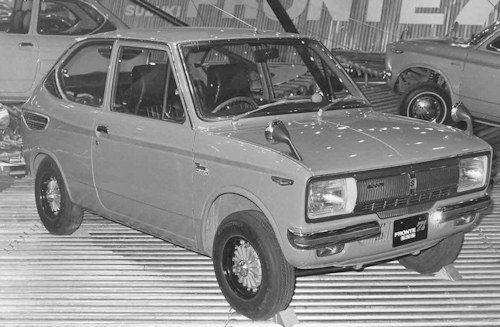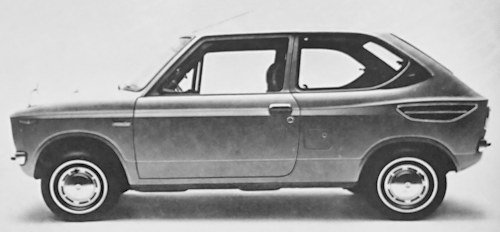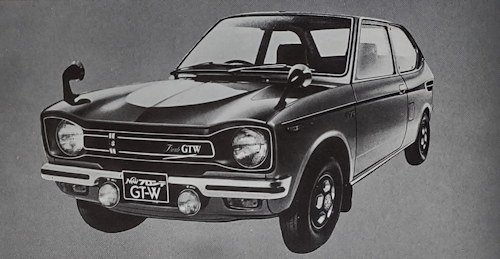Suzuki Fronte 3rd generation LC10 type II
 |
|
|
Production |
November 1970 to July 1973 |
|
Class |
Motor car |
|
Body type |
2-door fastback sedan/coupe |
|
Drive system |
Rear wheel drive |
|
Engine |
0.356 L water-cooled in-line 3-cylinder |
|
Maximum output |
34ps/6,000rpm |
|
Maximum torque |
4.2kgm/4,500rpm |
|
Wheelbase |
2,010mm |
|
Length |
2,995mm |
|
Width |
1,295mm |
|
Height |
1,295mm |
|
Vehicle weight |
475kg |
The Suzuki Fronte third generation was a small car built by Suzuki in the 1970s as the models 71,72 and 73 LC10 type II .
History
The Suzuki Fronte from Suzuki Motor Co. Ltd, was a small notchback version of the Suzuki Suzulight TL Van and was introduced in March 1962 the Suzuki fronte first had a front transversely mounted two-cylinder, two-stroke engine, which drove the front wheels. In October 1965, a further improved engine was introduced, with which the oil consumption was reduced. In addition, a larger version, the Suzuki Fronte 800, was introduced.1969 already anticipated design elements of the front 360 successor Suzuki Fronte 71.
The Sting Ray (stingrays) Fronte 71 launched in 1970 and was more of a sedan with a more hatchback look. Based on the Fronte 71 was introduced in September 1971, the Fronte Coupé, designed by Giugiaro and with a more powerful engine. This was replaced in 1976 by the Suzuki Cervo.
The car name is similar to the FF drive system adopted by the first model, but on the contrary, the RR (rear engine, rear drive) was adopted from the second to fourth generations. After the 5th generation, it returned to the origin in FF as a result. It was Suzuki's representative mini passenger car for many years until the derivative Alto appeared in 1979 and became a big hit. While the Fronte came as a passenger car with five model variants excluding the fronte van and fronte hatch described late), the initial Alto was released as a commercial model that shared the platform with the fronte.

For November 1970 for 1971 the 3rd generation Fronte (Fronte 71) was released with the model type name as LC10-II. The range came as a basic standard, deluxe, high deluxe, With sportier better equipped super deluxe at 394.000 yen.
PERFORMANCE: 31 hp
- max power (DIN): 31 hp at 6.000 rpm
- max torque (DIN): 27 ft. 3.7 kg m at 500 rpm
- max engine revs 6000 rpm
- Specific power 87 hp/l
- power-weight ratio: 32.6
- acceleration: standing 1/4 mile 21.5 sec
- speed in top at 1,000 rpm: 10.4 mph, 16.8 km, h
- fuel consumption: 78.5 m. imp gal, 65.3 m, US gal
PERFORMANCE: 34 hp
- max speed 75 mph, 120 km/h
- power-weight ratio 29.8 1b, hp, 13.5 kg: hp
- fuel consumption 56.5 m/ imp gal, 47 m; US gal
The more high performance super S, SSS, SSS-R. Price from 405,000 yen. The"R" in SSS-R means radial tires (135SR10 size) standard equipment. The body style was a fastback completely new design style with the distribution of weight of 36% to front axle, and 64% at rear axle. The vehicle height was set quite low at 1,260 mm (sport type), while the front trunk was expanded. It was commonly called " the Stingray Look”. Later in 1971 a sports car version the Fronte Coupe was released. Separate from the sedan range and initially commissioned by Giorgetto Giugiaro which continues until 1976.
PERFORMANCE:71 SSS
- max power (DIN): 36 hp at 7,000 rpm
- max torque (DIN): 27 1b ft. 3.7 kg m at 6,500 rpm
- max engine rpm: 8,000
- specific power: 101.1 hp/l;
- power-weight ratio: 28 lb/hp, 12.7 kg/hp
- acceleration: standing 1/4 mile 19.9 sec:
- fuel consumption: 62.8 m: imp gal. 52.3 m/ US gal
The engine is basically a conventional air-cooled 3-cylinder 2-stroke engine. The Standard, Deluxe and Super Deluxe came with a 31 hp version while the higher spec High super, S was raised to 34 horsepower fitted with 3 Mikuni.Villiers VM 22 semi-downdraught carburettors with the top models with 36 horsepower and 3 Mikuni-Villiers VM 24 horizontal carburettors. (The SSS series).
By May 1971 Additional release of Fronte 71W. A model equipped with a new more powerful water-cooled engine while maintaining the body of the Fronte 71. The model is known as the LC10W version. Initially, there will be three specifications the GL-W, GT-W, and GT-RW also the GS-W and GO-W with 34-horsepower engine from 399,000 yen to 433,000 yen. The engine is equipped with a newly developed water-cooled 2-stroke 3-cylinder. For cooling, a unique "dual radiator system" is used. The GL-W is 34 horsepower and the GT-W series is 37 horsepower.
PERFORMANCE: LC10W 72 water cooled
- ENGINE 34 hp
- max power (SAE): 34 hp at 6,000 rpm
- max torque (SAE): 30 1b ft. 4.2 kg m at 4,500 rpm
- power-weight ratio: 30.9 lb/hp, 14 kg/hp
- acceleration: standing 1/4 mile 20.2 sec.
- ENGINE 37 hp
- max power (SAE): 37 hp at 6,500 rpm
- max torque (SAE): 30 1b ft. 4.2 kg m at 4,500 rpm
- standing 1/4 mile 19.7 sec.
More updates followed for 1972 range the name changed to 72 (Seventy-Two) with only minor change. The design of the front grille has been changed, and the interior such as the dashboard and seats has been changed. Changed sports wheel cap design. The sports type of the air-cooled engine cars is now called "Business Series" and now the water-cooled sports cars are called "Sports Series".
For the 1973 range as the New Fronte 73 series again with only minor changes to chassis and running gear but the exterior undergoes major changes to windows and the bumper to the front grille and bonnet. The headlamps have been changed from a square 2-lamp type to a round 2-lamp type. Air-cooled cars are auto clutch only. The new sporty GT-TYPE II comes equipped with dual brake master cylinder and front disc brakes.
The range is replaced in 1974 by the fourth generation the 7-S types LC20, SS10/20.

Technical
-
Suzuki Fronte 3rd gen Technical details and specifications (1970-1973)
ENGINE: Air cooled
rear, transverse 2 stroke
cylinders: 3. in line
bore and stroke: 2.05 x 2.20 in. 52 x 56 mm
enggin capacity: 21.7 cu in. 356 cu cm
compression ratio 6.8. and 7.1
cylinder block: cast iron
cylinder head: light alloy
crankshaft bearings: 7. on ball bearings
lubrication: mechanical pump. injection to cylinders and crankshaft bearings. total loss system
carburation: 3 Mikuni.Villiers VM 22 semi-downdraught carburettors
fuel feed: mechamcai pump
cooling system: aircooled.
ENGINE: 71 SSS Sedan variant
compression ratio: 6.9
cylinder block: light alloy
carburation: 3 Mikuni-Villiers VM 24 horizontal carburettors.ENGINE: water cooled
compression ratio: 7.2:1 and 7.8:1
light alloy cylinder block
4 crankshaft bearings on ball bearings
3 Mikuni-Villiers VM 24 horizontal carburettors
water-cooled.
25 A alternator.
TRANSMISSION
driving wheels: rear
clutch: single dry plate (diaphragm)
gearbox: mechanical; gears 4 plus reverse:
synchromesh gears: 1st, 3rd, 4th
gearbox ratios: 1st 3.182. 2nd 1.875. 3rd 1.238. 4th O.88O. rev 2.727
final drive:- spiral bevel
axle ratio: 4.385CHASSIS
type integral
front suspension: independent. wishbones, coil springs, anti-roll bar, telescopic dampers
rear suspension: independent, semi-trailing artns, coil springs, telescopic dampers.STEERING
rack-and-pinion
turns of steering wheel lock to lock: 2.75.
turning circle (between walls): 25.6 ft, 7.8 mBRAKES
drum:
lining area front: 31.6 sq in, 204 sq cm,
lining area rear : 31.6 sq in. 204 sq cm,
lining area total: 63.2 sq in, 408 sq cm.ELECTRICAL EQUIPMENT
voltage: 12 V
battery: 24 Ah
generator type: dynamo, 300 W
ignition distributor: Mitsubishi or Nihon-DensoDIMENSIONS AND WEIGHT
wheel base: 79.13 in, 2,010 mm
front track: 44.09 in, 1.120 mm
rear track: 42.72 in, 1,085 mm
overall length: 117.91 in, 2,995 mm
overall width: 50.98 in, 1,295 mm
overall height: 50.98 in, 1,295 mm
ground clearance: 7.68 in, 195 mm
dry weight: 1,014 1b, 460 kg© Motor car History
Service
-
Suzuki Fronte 3rd gen maintenance and Service Guide (1970-1973)
Fuel type: mixture
Engine oil: 7 imp pt. 8.5 US pt, 4 1, oil in separate tank
Gearbox and final drive oil: 1.8 imp pt, 2.1 US pt, 1 1, SAE 90, change every 6 months
Greasing: none
Normal tyre pressure: front 14 psi, 1 atm, rear 24 psi, 1.7 atm.
Width of rims: 3.5"
Tyres: 5.20 x 10. or 135 x 10 tyres
Carrying capacity: 706 1b, 320 kg
Fuel tank capacity: 5.9 imp gal, 7.1 US gal© Motor car History
